A selection of beautiful astilbe varieties
| Content:
|
Astilbe is an ornamental herbaceous perennial from the Saxifraga family, which has gained enormous popularity among ordinary gardeners and professional landscape designers.This versatile flower can be grown in the country and in the garden, in the park and in the city square, in the garden and in an indoor pot. Plants are valued for their amazing beauty not only during flowering, but also after its completion. This article talks about the numerous types and varieties of astilbe, their characteristics and growing conditions.
|
The abundance of varieties and types of astilbe allows it to be used in landscape design in a variety of ways. After all, varieties of this plant are both dwarf and tall. |
What types of astilbe are there?
About four dozen different types of astilbe grow in the natural environment. Taking just a dozen of them as a basis, breeders have already developed about three hundred varieties, and this number continues to constantly increase. Each type and variety has its own characteristics and individual characteristics. They vary in color and size, flowering time and shape of inflorescences, winter hardiness and growing conditions, beauty and durability.
- Arends – consists of several dozen varieties and hybrids of various colors. All of them are distinguished by a long flowering period, lush paniculate or racemose inflorescences and high decorative value. The average height of a spreading bush is about one hundred centimeters. The crops consist of powerful and long peduncles, feathery leaf plates of a dark green hue and bright inflorescences.
- Japanese - has about two dozen low-growing varieties with a height and width of forty to sixty centimeters. Most specimens are distinguished by early flowering. The crops consist of densely structured leaves of a dark green hue with a shiny surface and inflorescences of a varied palette.Plants have a negative attitude towards open sunny areas and lack of moisture.
- Chinese - a perennial species that combines varieties of different heights with long and abundant flowering. It includes dwarf and tall plants with dense paniculate inflorescences of pink and purple shades. Ground cover specimens are especially in demand when designing alpine slides and rock gardens.
- Korean - consists of varieties that bloom for fifteen to twenty days in July - August with drooping inflorescences in white or cream tones. The height of the bush is about seventy centimeters, the length of the inflorescences is up to twenty-five centimeters. For planting, it is recommended to choose slightly shaded areas with moderate humidity.
- Simpleleaf – a valuable, but not very common species, characterized by high decorativeness and small growth. The average height of its varieties is from twenty to fifty centimeters, the diameter is about half a meter. Prefers to grow in shade or partial shade, near water bodies, in areas with moist air and away from bright sunlight. The bushes are decorated with leaves and inflorescences of various shades.
- Thunberg – a spectacular, rarely seen species consisting of medium-sized perennials with drooping inflorescences. Their decorative potential peaks at the end of July or beginning of August. The average height of the bush is about eighty centimeters. It consists of straight stems, oval leaves with a jagged edge, lush pink or lilac racemes up to twenty centimeters long.
- Naked - combines low-growing and dwarf varieties with high winter hardiness, not exceeding twenty to thirty centimeters in height. For lush and long flowering, abundant and regular watering is required. Blooms in pale pink shades in July–August.Loves shady areas.
- David – varieties of this species are distinguished by short but very effective flowering and rather tall growth. The height of the bush often reaches one hundred and fifty centimeters. Distinctive features of the plants are feathery light green leaves, fluffy inflorescences - panicles up to forty centimeters long in lilac and pink tones.
Red and pink varieties of astilbe
Delft Leys (Delft Lace)
|
A resilient astilbe variety of German origin is highly decorative and resistant to pests. |
An interesting feature of the plants is the carved leaf plates that change color with each season. In spring they are painted in burgundy shades, in summer - light and dark green, and in autumn - bluish-gray.
- The height of the bush is about eighty centimeters, the width of the crown is up to half a meter.
- When groundwater is close, flowering is long and abundant. Throughout the summer season, you can admire the bright, rich pink inflorescences and inhale the delicate aroma of plants.
- For planting, you should choose moist soils in semi-shaded areas.
- Withstands frosts up to thirty-five to thirty-eight degrees, suitable for growing in the Moscow region and most of Russia.
Astilbe Arends does not tolerate stagnation of moisture in the soil and multi-day drought. She is an excellent honey plant that attracts large numbers of bees.
Hip Hop
|
A hardy hybrid variety of Chinese astilbe differs from others in its beautiful openwork leaves, two-colored inflorescences (pink and red) and early flowering. |
Astilbe Hip-Hop tolerates extreme heat and direct sunlight, as well as severe winter frosts. Used for site decoration and cutting.
- A compact, beautiful shrub grows up to seventy centimeters in height, the average length of the inflorescence is twenty centimeters.
- The first inflorescences appear in early July and last until the end of the summer season.
- For planting, you should choose open sunny places with moist soil.
- Withstands frosts up to forty degrees without shelter. Recommended for the Middle Zone and Moscow region.
Astilbes are excellent neighbors with roses, carnations, phlox, coniferous trees and shrubs.
Peach Blossom
|
The perennial variety of Japanese astilbe is known for its lush pink blooms and demanding growing conditions. |
The variety is not recommended for southern regions, as it reacts negatively to dry air and elevated temperatures.
- The dimensions of the spreading shrub are about sixty centimeters in length and width. The length of the inflorescences is fifteen centimeters.
- The plant blooms in the second half of summer for four weeks.
- Planting should be done only in partial shade, in areas with diffuse lighting.
- Suitable for growing in central and northern regions with winter temperatures of about twenty-five degrees below zero.
Conifers, hostas, irises, tulips and phlox will be good neighbors for astilbe.
Aphrodite
|
A popular and beautiful variety of astilbe simplefolia is distinguished by the delicacy of its leaf blades and the brightness of its inflorescences. |
The flowering shrub attracts attention with pink, red, burgundy shades, which are simultaneously on the same plant. It has shiny green leaves and graceful reddish flower stalks.
- The average height is about fifty centimeters.
- In the second ten days of July, the crops begin to flower, which continues until the beginning of August.
- A favorable planting location is a semi-shaded area with diffused lighting, fertile soil, and high humidity.
- Plants can be grown in regions with winter temperatures up to thirty degrees below zero.
Dried inflorescences are used to create winter bouquets and various compositions.
Chocolate Cherry (Mighty Сhocolade Сherry)
|
The young hybrid variety of Dutch origin is unique due to the likelihood of repeated flowering. This is only possible with proper care - with timely cutting of flower stalks and regular fertilizing. |
Tall crops attract attention with their brown leaves with red edges and velvety inflorescences in purple-red tones.
- The bush grows up to one hundred to one hundred and twenty centimeters in height (including peduncles).
- It blooms in July–August for eight or more weeks.
- You can plant bushes in shade and partial shade, on moist, nutritious soil with good drainage.
- The frost-resistant variety can withstand frosts down to thirty-five degrees and is recommended for cultivation in the Urals, Far East, and the Middle Zone.
Inflorescences cut for bouquets are short-lived. Even in a container with water, they retain their beauty and attractiveness for only a few hours.
Burgundy Red
|
An unpretentious perennial variety of Astilbe Arends will attract attention in any garden with its beautiful, rich red color of panicle inflorescences and their delicate aroma. |
Graceful openwork leaves remain dark green and attractive throughout the season. Crops can be grown outdoors and indoors as a houseplant.
- The average height is about sixty centimeters, the length of the inflorescences is from twenty to thirty centimeters.
- The flowering period begins in early July and lasts about forty days.
- For planting, you must choose a sunny or slightly shaded area with fertile and moisture-permeable soil.
- Plants winter well in the conditions of the Moscow region, but only with additional shelter. In late autumn, it is recommended to mulch the bushes at the base with leaves or sawdust.
Beautiful white varieties
White Gloria
|
An unpretentious hybrid variety with dark green shiny carved leaves and dense diamond-shaped inflorescences of a white hue. |
In summer, a brown border appears on the leaf blades. Crops love regular watering, especially during hot, dry periods. The variety is used for decorating the site and for cutting.
- The average height of an adult shrub is from sixty to eighty centimeters, the width is up to half a meter, the length of the paniculate inflorescences is about fifteen centimeters.
- Fragrant, lush and abundant flowering lasts about two to six weeks, depending on the local climate. Flowering begins in mid-July.
- Bushes are planted in shaded areas with no direct sunlight during the day. The soil should be well moist and fertile.
- The variety does not tolerate severe frosts, so it is not suitable for northern regions with harsh winters. In the Moscow region, astilbe can be grown under cover in winter.
Washington
|
An interesting variety of Japanese astilbe with fern-like light green leaves and creamy white flowers. |
Paniculate white inflorescences look great in group and single plantings, on lawns and near artificial reservoirs. Plants are endowed with high survival rate and good disease resistance.
- The average height during the flowering period is about seventy centimeters.
- Plants begin to bloom at the end of June and end at the beginning of August.
- Planting must be done in areas with high humidity, in diffuse shade, with obligatory shading during the midday hours.
- Frost resistance is average. This variety can be grown in the Moscow region.
Dried astilbe inflorescences should not be cut off; they remain an elegant decoration of the garden until late autumn.
Gladstone
|
The shade-tolerant and moisture-loving variety of Japanese astilbe is popular among gardeners due to its durability and unpretentiousness. |
The compact shrub consists of pearly white paniculate inflorescences and dark green leaves with a shiny surface. Strong immunity allows you to resist various diseases and pests.
- The average height of the bush is from fifty to sixty centimeters.
- In mid-July, the first buds begin to open and slightly drooping inflorescences appear. The flowering period lasts from two to four weeks.
- Plants can only be planted in fertile soil with high humidity. The planting site should be chosen near tall trees and shrubs, near buildings that create diffuse lighting.
- The winter hardiness of the variety is high.
As neighbors for this variety, you should pay attention to cereal crops, heuchera, hosta and bergenia.
Milk and Honey
|
A drought-resistant, early-flowering variety of Chinese astilbe consists of openwork leaves with a shiny bronze-colored surface, lush and large white inflorescences. |
Crops are often used for cutting, making bouquets and plant arrangements.
- The average height of an adult plant is from forty to sixty centimeters.
- Abundant flowering lasts thirty - forty days, in July - August.
- Open sunny areas with nutritious, breathable soil and moderate humidity are suitable for planting.
- Frost resistance is about twenty-nine degrees. This variety can grow in the Far East, in the Moscow region and in some areas of the Middle Zone, but with the obligatory organic shelter.
Deutschland
|
The snow-white variety of Japanese astilbe is a spreading bush consisting of fragrant fluffy diamond-shaped inflorescences and dark green leaves with a glossy surface. |
It is recommended to feed the crops two to three times a year and mulch them at the base.
- An adult plant grows up to half a meter in height and width. The length of the inflorescences is about twenty centimeters.
- In the first days of July, the first flowers open. They delight with their lush inflorescences for twenty to twenty-five days.
- Astilbe can fully develop in sunny and semi-shaded areas, but only with proper care. The soil on the site should be moist and fertile.
- In the Moscow region it winters without shelter at temperatures down to twenty-five degrees. In the central zone, plants are covered with artificial or natural materials for the winter.
It is not recommended to use pine needles, cones, or crushed bark of coniferous trees as mulch for astilbe.
Tall varieties
Purpurkerze
|
The fragrant late-flowering variety of Chinese astilbe is considered one of the most spectacular. |
The bush consists of a large number of tough green leaves with a hint of bronze and dense fluffy inflorescences in purple and violet tones. Dense flower thickets do not give any chance to weeds and are a serious obstacle for them.
- The average height of an adult culture is from one hundred twenty to one hundred and fifty centimeters.
- The flowering period lasts from early August to mid-September.
- For seedlings, it is worth choosing shaded areas in southern climates and open sunny areas in regions with a cool and humid summer season. The soil should be rich in composition, moist and breathable.
- Winter hardiness is good, the variety is recommended for the Middle Zone.
The name of the variety translated from German means “purple candle”. Astilbe inflorescences are used to create fresh and dry bouquets.
Pomegranate (Granat)
|
The popular Arends astilbe variety belongs to the tallest specimens. |
Its openwork carved leaves with a shiny surface and bright pyramidal inflorescences in pink and blood red tones attract attention not only with their beauty, but also with a pleasant honey aroma. Paniculate inflorescences occupy approximately two-thirds of the height of the entire bush.
- Under favorable conditions and proper care, an adult plant often reaches a height of two meters.
- Plants bloom for forty to forty-five days, starting in the second half of July.
- For full growth and development, it is necessary to choose moist, nutritious soils for astilbe in open or semi-shade areas.
- Frost resistance is average; under cover it tolerates frosts down to twenty-five to thirty degrees. Cultivation is possible in some regions of the Middle Zone.
Pomegranate is an excellent honey plant. As a decoration, it is suitable for flower beds and garden areas of any type.
Diamond (Diamant)
|
The frost-resistant hybrid variety of Arends' Astilbe is a tall, spreading, pyramidal-shaped bush. |
It consists of strong and thin stems, a small number of dark green leaf blades and white small flowers with a pleasant aroma, collected in racemes.It has strong immunity to diseases and pests.
- The height of the bush is from ninety centimeters to one and a half meters, the width in diameter is from fifty to seventy centimeters.
- It blooms for six to six and a half weeks - from mid-July to September.
- Planting requires moist, fertile areas without stagnant water, in an open area under direct sun or in places with diffuse lighting.
- Winter-hardy variety, suitable for growing in the Moscow region.
Ostrich feather (Straussenfeder)
|
Ostrich feather is one of the best varieties of astilbe. The unpretentious and highly decorative variety of Thunberg astilbe is known and very popular among gardeners and flower growers. |
This bright representative of the Saxifraga family is distinguished by its tall growth, spreading crown, long flowering, and spectacular appearance. Lush and long drooping inflorescences of pink and coral shades, jagged green leaf plates on long petioles, many erect red-brown shoots - all this forms a dense, spreading bush.
- The width of the crown and the height of the bush are approximately the same and range from ninety centimeters to one meter. Sometimes the height reaches one hundred and twenty centimeters. The length of the inflorescences is up to forty centimeters.
- It blooms late and for a long time - from the second half of August to October.
- Crops prefer sunny areas with light shading at midday, regular watering, and places with close groundwater.
- A universal variety in terms of frost resistance, it is recommended for the Moscow region, the Middle Zone and the southern regions.
In the first two years after planting, crops require close attention and regular care. In the future, the plants will become more independent.
Amethyst
|
An early frost-resistant variety of Arends' astilbe is characterized by rapid growth, good resistance to diseases and pests, and high decorative properties before, during and after flowering. |
The medium-leafed shrub consists of small leaves in green and brown tones, paniculate inflorescences of large lilac-violet flowers up to six centimeters in diameter.
- The bush is tall - one hundred to one hundred and twenty centimeters, diameter - from half a meter to eighty centimeters. The length of the inflorescences is about thirty centimeters.
- Begins to bloom at the end of June. The flowering period lasts about a month.
- Plants require a shaded area with loose soil and low acidity. Crops respond positively to close groundwater.
- The variety tolerates frosts up to thirty degrees under snow cover. In snowless winters, bushes must be covered. Winters well in the Moscow region.
It is recommended to plant the honey plant in close proximity to the apiary.
Low-growing, dwarf varieties of astilbe
Vesuvius
|
An unpretentious, low-growing Japanese variety with leaves that change color (from burgundy to green) and paniculate inflorescences with small red-burgundy flowers. |
Plants are used to decorate a garden, flower bed, open terrace, loggia, balcony and as an indoor flower.
- The average size of the crop is fifty centimeters in height and about ten centimeters in the length of the inflorescences.
- It blooms for three to four weeks in July – August.
- For planting, you need fertile, moist soil, pre-fed with organic matter. The area should be semi-shaded.
- The average frost resistance of the variety allows it to remain viable at temperatures up to twenty degrees below zero.
The variety is highly resistant to pests and climatic conditions of different regions.
Younique Carmine
|
The popular hybrid variety of Astilbe Arends is used for decorating flower beds, flower beds, and garden plots. The flower feels great in a container and as an indoor plant. |
The compact bush consists of complex pinnate leaf plates of rich green color, dense purple-red inflorescences - panicles. During the period of lush flowering, leaves are practically not visible on the bushes.
- The average height of the plant is from thirty to forty centimeters.
- The flowering period lasts three to five weeks and begins in mid-July.
- The bushes grow fully on moist soils in diffused or partial shade lighting. Container growing requires a drainage layer.
- Winter hardiness is high, plants can withstand frosts up to thirty-four degrees. The variety is suitable for the Moscow region and the Central zone.
When growing astilbe in a flower container, the plants will need to replant and divide the rhizomes every five years.
Moulin Rouge
|
The dwarf ground cover variety of curly astilbe is ideal for container growing, but feels great in open ground, in a flower garden, on an alpine hill, in a garden and backyard. |
Plants consist of curly foliage with a bronze tint in spring, numerous paniculate inflorescences in pink, crimson or red.
- The height of the miniature plant is from fifteen to twenty centimeters.
- Astilbe blooms in June - July.
- For planting, a semi-shaded area with a high level of humidity and close groundwater is required. At midday, plants will need reliable shading.
- High winter hardiness. The variety is suitable for the Moscow region, Leningrad region, and some regions of the Central zone.
Crops easily tolerate stagnant water on the site, but cannot survive prolonged drought and lack of moisture.
Don't forget to read:
Sprite
|
A frost-resistant ground cover and beautiful variety of astilbe simplefolia blooms with drooping paniculate inflorescences of light pink shades. |
The dark green leaf blades have an unusual openwork shape with teeth along the edge. Landscape designers use astilbe in mixborders, on alpine hills, and near artificial reservoirs.
- The height of the dwarf variety is from fifteen to twenty centimeters, together with inflorescences – up to thirty centimeters. The diameter of the culture can grow up to one meter.
- Lush flowering can be observed in July – August.
- The universal variety can grow in almost any area; there are no special requirements for the composition of the soil, but wet areas are most favorable.
- Withstands frosts up to twenty-eight degrees without shelter.
The fountain-like shape of the bush can be observed twice a season, since the variety is a repeat-flowering plant.
Lilliput
|
A spectacular slow-growing variety of curly astilbe consists of dark green corrugated leaves with barely noticeable fibers on the surface and paniculate inflorescences in pink and salmon shades. |
The crops coexist well with ferns, various flowering perennials and annuals. Often used on alpine slides.
- The height of adult plants is from fifteen to twenty-five centimeters.
- It blooms for three to four weeks, starting in July.
- Planting requires a semi-shaded area with moist, loose and fertile soil.
- Winter hardiness is high. Possible cultivation in the Moscow region and some regions of the Middle Zone.
Lilliput grows well indoors, as well as in flowerpots and containers outdoors or on the balcony.
Visions in Red
|
A variety of Chinese astilbe with a powerful and compact rhizome, green lacy leaves with a shiny surface, dark red shoots and beautiful deep red or purple inflorescences. |
Due to the rapid growth of the root part, it is recommended to hill the base of the bush annually with dry soil or peat.
- The average height of a bush without peduncles is about thirty centimeters, with peduncles - up to half a meter, crown diameter - up to forty centimeters.
- It blooms from the second decade of July to mid-August for three to four weeks.
- For planting, an area with loose, moist and fertile soil, slightly acidic or neutral, in light partial shade is required.
- In snowless, frosty winters with temperatures above twenty-five degrees, plants must be covered with natural materials - straw, leaves, sawdust, spruce branches.
The variety is used for planting in rock gardens, rocky gardens, as a frame for paths and flower beds.
Conclusion
The variety of species and varieties of astilbe allows every lover of flowering plants to choose the most suitable specimen for themselves.
Similar articles:
- Description and photos of beautiful heuchera varieties ⇒
- Description of the 25 best varieties of herbaceous peonies with photos and names ⇒
- Beautiful hosta varieties with descriptions, photos and names ⇒
- The most beautiful varieties of perennial delphiniums with photos and names ⇒
- Varieties of multiflora chrysanthemums (spherical) with photos and names ⇒
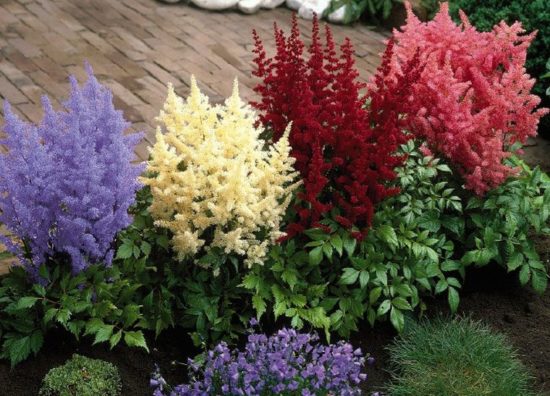
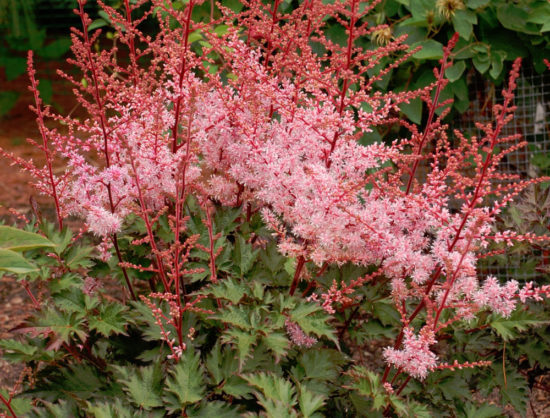
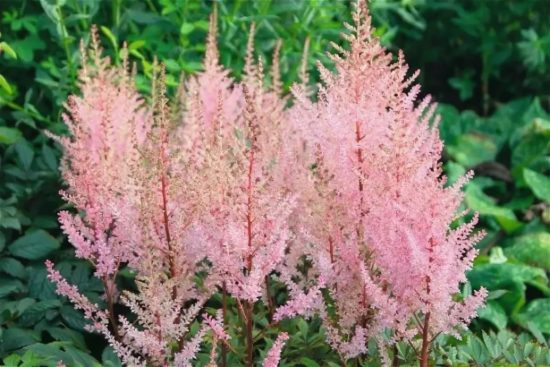
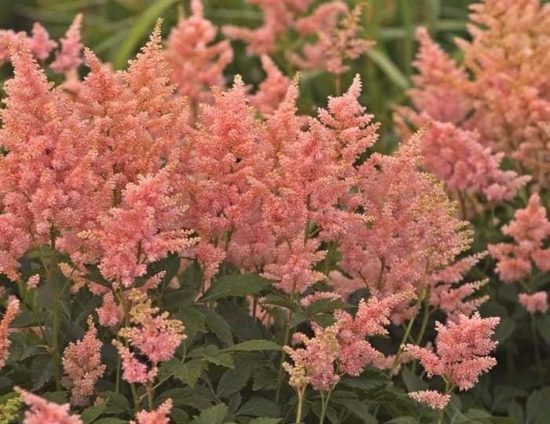
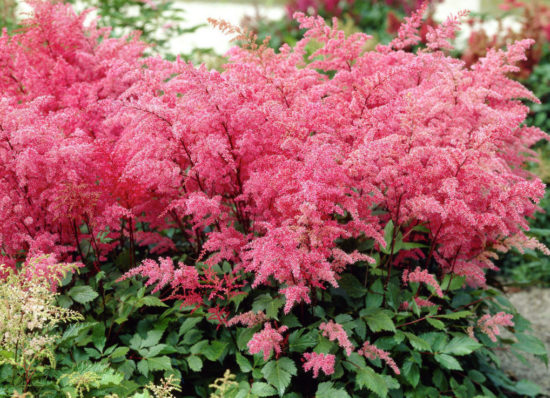
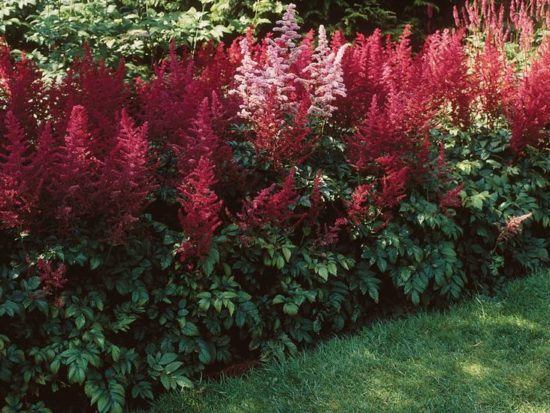

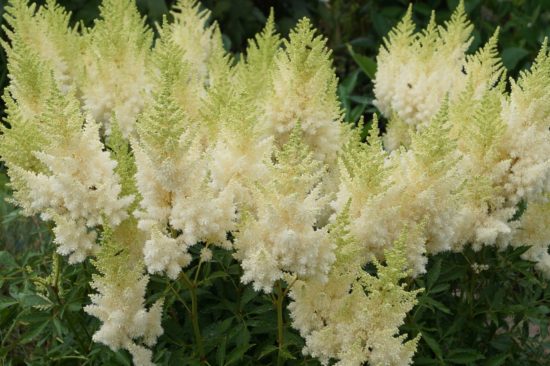
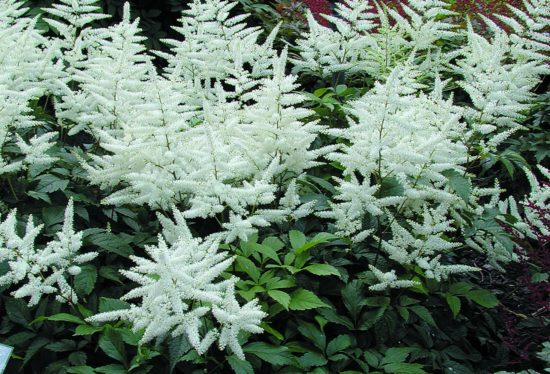
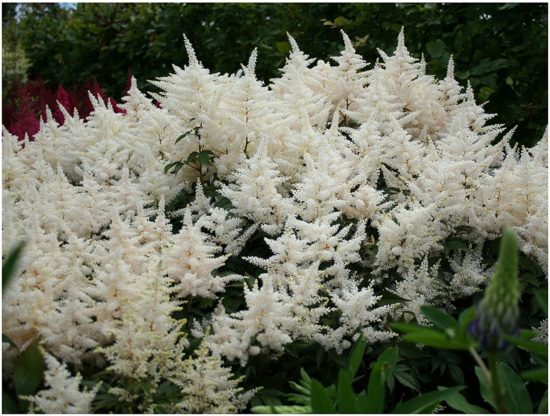
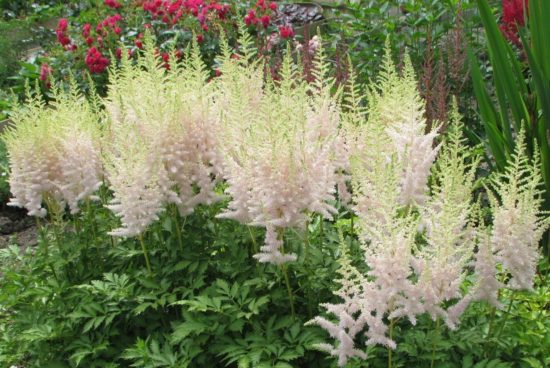

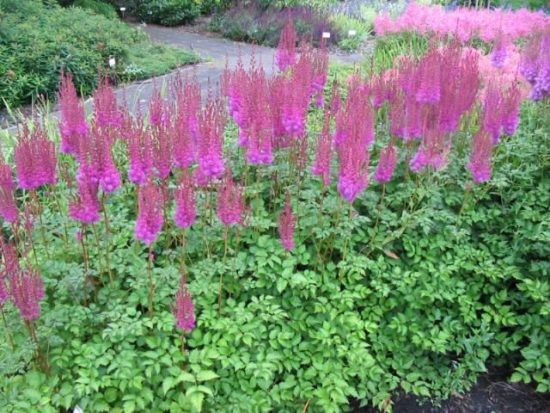
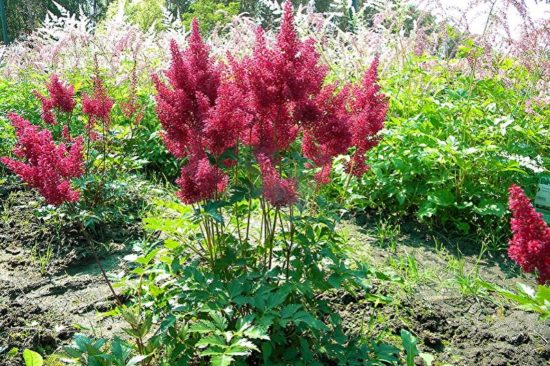
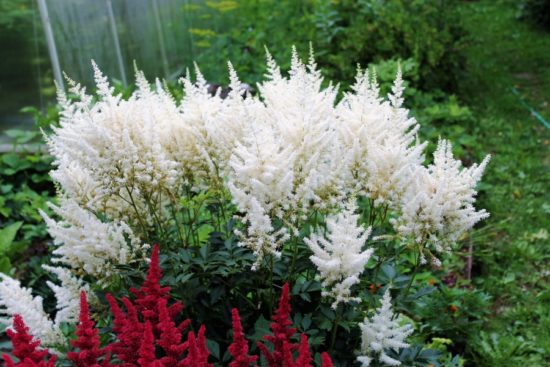
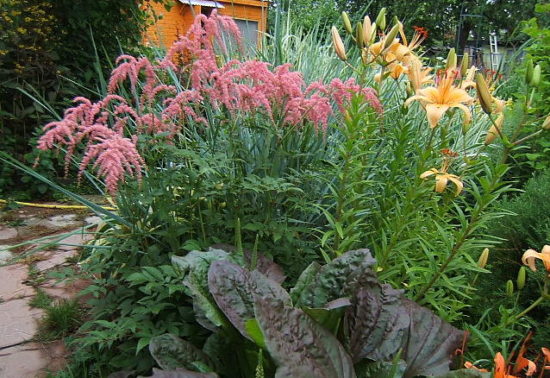
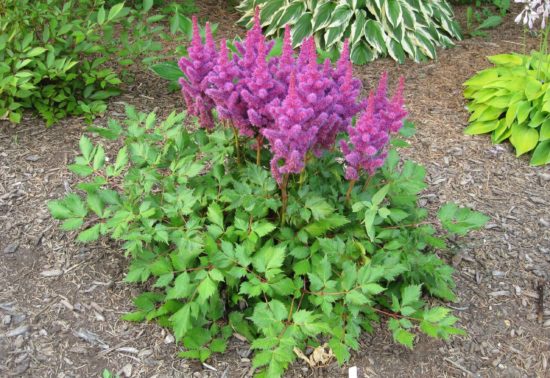
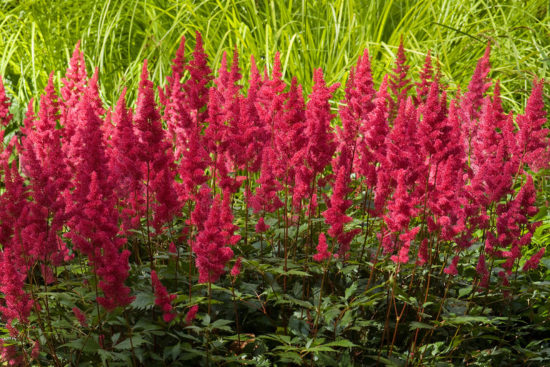
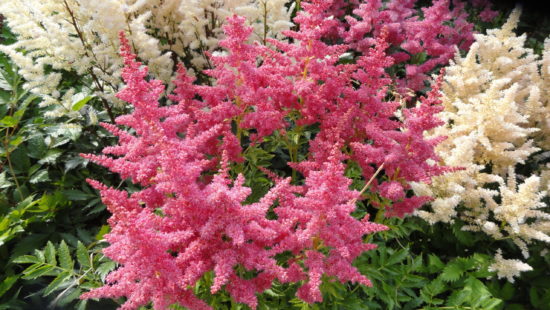
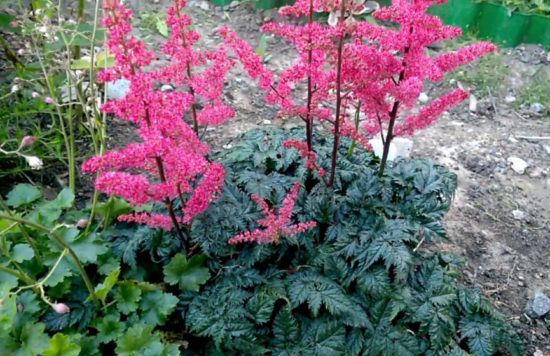
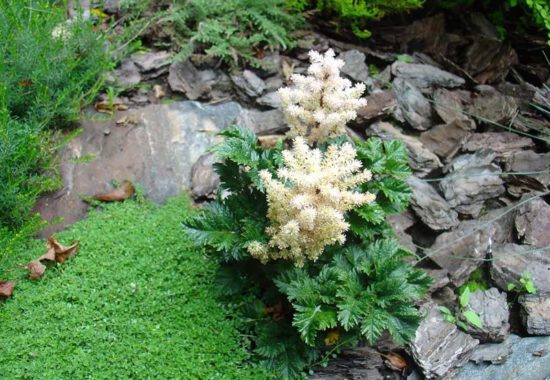
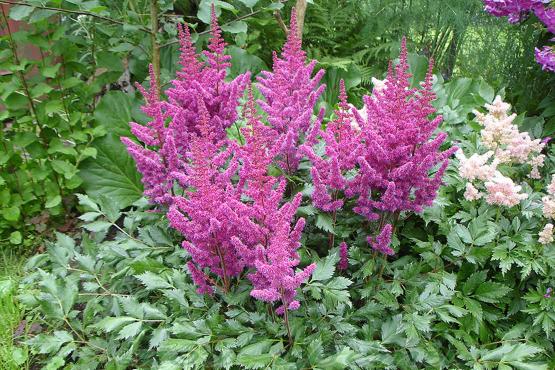


 (3 ratings, average: 3,33 out of 5)
(3 ratings, average: 3,33 out of 5) CUCUMBERS NEVER GET SICK, I'VE BEEN USING ONLY THIS FOR 40 YEARS! I SHARE A SECRET WITH YOU, CUCUMBERS ARE LIKE THE PICTURE!
CUCUMBERS NEVER GET SICK, I'VE BEEN USING ONLY THIS FOR 40 YEARS! I SHARE A SECRET WITH YOU, CUCUMBERS ARE LIKE THE PICTURE! You can dig a bucket of potatoes from each bush. Do you think these are fairy tales? Watch the video
You can dig a bucket of potatoes from each bush. Do you think these are fairy tales? Watch the video
 How our fellow gardeners work in Korea. There is a lot to learn and just fun to watch.
How our fellow gardeners work in Korea. There is a lot to learn and just fun to watch. Eye trainer. The author claims that with daily viewing, vision is restored. They don't charge money for views.
Eye trainer. The author claims that with daily viewing, vision is restored. They don't charge money for views. A 3-ingredient cake recipe in 30 minutes is better than Napoleon. Simple and very tasty.
A 3-ingredient cake recipe in 30 minutes is better than Napoleon. Simple and very tasty. Therapeutic exercises for cervical osteochondrosis. A complete set of exercises.
Therapeutic exercises for cervical osteochondrosis. A complete set of exercises. Which indoor plants match your zodiac sign?
Which indoor plants match your zodiac sign? What about them? Excursion to German dachas.
What about them? Excursion to German dachas.